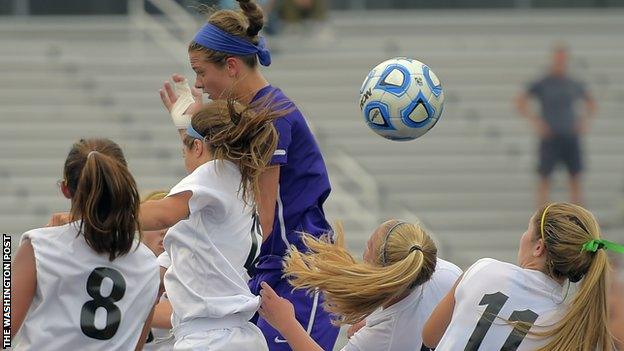Scottish FA heading ban: Is United States model the answer?
- Published

The United States banned heading for under-10s in 2015
Scotland is set to become the first European nation to impose restrictions on children heading footballs.
The move comes after a report found, external that former players were at greater risk of dying from dementia than those who did not play the sport.
But how will the Scottish FA implement such restrictions?
One way might be to look towards the United States, which has already banned heading in youth football.
What triggered US Soccer to change?
US Soccer was forced to change its rules when a group of players and parents in California filed a class-action lawsuit in 2014 against Fifa, US Soccer and the American Youth Soccer Organisation.
The lawsuit stated that the three governing bodies had been negligent and sought an injunction on impact collisions within football and a limit on the number of times a player under 17 could head a ball.
This led to the United States Soccer Federation issuing a mandate in November 2015 - called the Recognise to Recover Program - which stated that players aged 10 or younger would be prohibited from heading the ball and the practice would be greatly reduced for those aged between 11 and 13.
The rule came in to effect on 1 January 2016 and was implemented at every youth national team and academy within US Soccer and youth teams at Major League Soccer clubs.
What did they do?
The new rules stated that players aged 10 or younger would no longer be taught to head the ball and could not intentionally do so in games. The updated rules for US Soccer stated:
When a player deliberately heads the ball in a game, an indirect free-kick should be awarded to the opposing team from the spot of the offence. If the deliberate header occurs within the goal area, the indirect free-kick should be taken on the goal area line parallel to the goal line at the point nearest to where the infringement occurred.
Players aged 11 and 12 would be taught the skill and allowed to head the ball in a match. However, training drills that focused on heading would be limited to 30 minutes per week.
The rules also stated that a player suspected of suffering a head injury would be substituted for evaluation without that substitution counting towards the limited amount the team were allowed in that match.
What impact has it had?
The changes have only been in place for three years, meaning evidence on any long-term impact on youth players is lacking. However, it has led to a drastic change in the way young players are coached.
"I was sceptical at first but I'm more in to it now," said Tommy Wilson, a Scot who is director of the Philadelphia Union Academy. "Training is split into different age groups and you only learn certain aspects of the game at under-12 - keeping a high defensive line, overcoming offsides, etc.
"You teach them what is age-appropriate. So it just means now that we spend a bit more time doing heading when the boys are a little bit older.
"You can use lighter balls, so they don't feel as hard an impact. Our understanding from American football is that it's more about the impact from other players rather than the actual heading of the ball. That's why we take the guidance of the medical professionals."